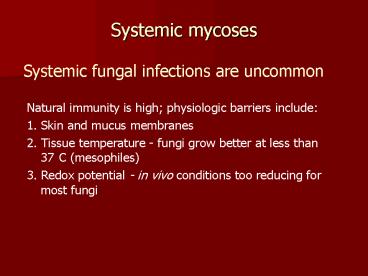Systemic mycoses - PowerPoint PPT Presentation
1 / 14
Title:
Systemic mycoses
Description:
Infection requires a large inoculum and is affected by the resistance of the host ... Amphotericin B, Fluconazole. Histoplasmosis (also called cave disease) ... – PowerPoint PPT presentation
Number of Views:1475
Avg rating:3.0/5.0
Title: Systemic mycoses
1
Systemic mycoses
Systemic fungal infections are uncommon
Natural immunity is high physiologic barriers
include 1. Skin and mucus membranes 2. Tissue
temperature - fungi grow better at less than 37C
(mesophiles) 3. Redox potential - in vivo
conditions too reducing for most fungi
2
Infection requires a large inoculum and is
affected by the resistance of the host
- infection often occurs in endemic areas
- most infections are asymptomatic or self-limiting
- in immune-compromised hosts, infections are more
often fatal (distinction between infection and
disease)
3
Infection requires a large inoculum and a
susceptible host
- infection often occurs in endemic areas
- most infections are asymptomatic or
self-limiting - in immune-compromised hosts, infections are more
often fatal
Systemic fungal disease is most often associated
with three organisms
1. Coccidioides immitis 2. Histoplasma
capsulatum 3. Blastomyces dermatitidis
4
Coccidioidomycosis
- Coccidiodes immitis is considered to be the most
virulent of fungal pathogens. - Restricted to hot, semi-arid areas of SW USA and
Mexico. - Grows in the soil, but inhalation of a single
spore can initiate infection.
Conidia
In infected tissues, C. immitis appears as a
mixture of hyphae and spherules.
Spherules
5
Coccidioidomycosis Normally a benign,
sub-clinical upper respiratory infection
In a small percentage of cases, organism
disseminates from the lungs to a variety of
organs, particularly the CNS, meanings, skin,
soft tissues, and bone.
6
In infected tissues, organism is seen as a
mixture of spherules and endospores.
7
Risk factors for disseminated coccidioidomycosis
1. Race Filipinos gt African Americangt
Caucasian 2. Age Extremes more
susceptible 3. Sex Males more susceptible 4. Preg
nancy 5. Immunosuppression
Diagnosis
1. Suppurative or granulatomas inflammation 2. Sph
erule or endospores seen on pathology 3. Culture
of microorganisms 4. Complement fixation assay
(in cerebrospinal fluid)
Treatment
Amphotericin B, Fluconazole
8
Histoplasmosis
- (also called cave disease)
Caused by the dimorphic fungus Histoplasma
capsulatum
Tuberculated macroconidia, grown at 25C
Intracellular yeast at 37C
Histoplasmosis is characterized by intracellular
growth of the pathogen in macrophages and a
granulomatous reaction in tissue. These
granulomatous foci may reactivate and cause
dissemination of fungi to other tissues.
9
Histoplasmosis
- 1. Usually, acute benign respiratory disease
- 2. Rarely, progressive, chronic or disseminated
disease - 3. Endemic area in U.S. -Atlantic Ocean to N.
Dakota (500,000 cases/year in U.S.), except New
England Florida. Most cases in Ohio Valley and
Mississippi Valley)
H. capsulatum grows in soil.
10
More Histoplasmosis
90 of histoplasmosis cases are clinically
insignificant
- 1. Disseminated histoplasmosis is diagnosed
frequently in patients with AIDS living in the
central U.S. - 2. It is often the initial manifestation of
immunodeficiency. - 3. In these cases, the organism spreads via blood
from the lung to involve bone marrow, liver,
spleen, or skin. - 4. Spread can also be associated with underlying
lung disease (e.g., emphysema).
Diagnosis
- Histology and culture
- Skin test for histoplasmin the major hyphal
antigen is not useful, because most people are
positive in endemic area.
11
Diagnosis
- Histology and culture
- Skin test for histoplasmin the major hyphal
antigen is not useful, because most people are
positive in endemic area.
Therapy
- Amphotericin still mainstay of therapy vs.
disseminated histoplasmosis. - Ketoconasole or itraconasole is effective as
therapy for self-limited disease (used in AIDS).
12
Blastomycosis
- Granulomatous mycotic infection that
predominantly involves lungs and skin but can
spread to other organs. Most prevalent in males
40-60 years of age and children.
Blastomyces dermatitidis
Dimorphic organism originates in the soil and
infection ensues by inhalation of spores.
Converts to yeast in animal hosts or at 37o in
vitro.
13
Blastomycosis
- Encounter Most cases are in southern, central,
and southeastern USA. Infection is by
inhalation of spores. - Spread The pulmonary infection is either self
-limited or progressive. Dissemination often
occurs to the skin and to the bone - 80 of
patients have large skin lesions a large number
also have granulomatous pulmonary lesions. - Risk Factors Occupational contact with soil
owning a dog. Living in endemic area. - Diagnosis based on clinical findings and
microscopic detection of organisms in tissue
specimens
14
Blastomycosis
Immune response
- 1. Alveolar macrophage provide a first line
of defense. - 2. T-cell stimulated PMNs kill Blastomyces cells
by oxidative mechanisms). - Conidia are more sensitive to killing by PMNs
because yeast are too big. - TH-1 response of primary importance
Treatment
- Amphotericin B is the drug of choice for rapidly
progressive blastomycosis - Itraconazole or Ketoconazole for less severe cases































